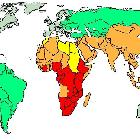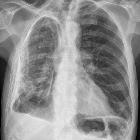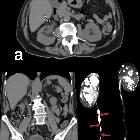tuberculosis























Tuberculosis (commonly abbreviated to TB, short for tubercle bacillus) encompasses an enormously wide disease spectrum affecting multiple organs and body systems predominantly caused by the organism Mycobacterium tuberculosis. A small proportion can also be caused by Mycobacterium bovis.
Epidemiology
Although tuberculosis continues to be very common in developing nations. Approximately 10 million people globally per year have positive exposure to tuberculosis . In Western industrialised populations it has become uncommon but is increasing in prevalence among immunocompromised patients, particularly those with HIV/AIDS. An estimated 5% HIV patients have Mycobacterium tuberculosis infections, which become clinically apparent when CD4+ counts drop to below 350 cells/mm, typically with findings of post-primary pulmonary tuberculosis .
Clinical presentation
Clinical presentation will depend upon the morphology of infection and location. These are discussed in separate articles.
- morphology
- location
History and etymology
Aristotle is usually credited as being the first to recognize the contagious nature of the disease. Discovery of the specific infectious agent, the tubercle bacillus (Mycobacterium tuberculosis), did not occur for several millennia until it was isolated by Robert Koch in 1882 . M. tuberculosis was previously known as Koch bacillus and tuberculosis known as Koch disease. It was also historically known as consumption due to the severe associated weight loss.
Siehe auch:
- pulmonale Tuberkulose
- Pleuraplaques
- Miliartuberkulose
- Tuberkulose des ZNS
- Nierentuberkulose
- miliare Lungenherde
- pleurale Tuberkulose
- Kavernöse Lungenläsionen
- mycobacterium tuberculosis
- primary pulmonary tuberculosis
- Tuberkulose des Peritoneums
- tuberkulöse Spondylitis
- tuberkulöse Halslymphknoten
- urogenitale Tuberkulose
- post primary pulmonary tuberculosis
- Pleuritis exsudativa
- multiresistente Tuberkulose
- Tuberkulose der Mamma
- tuberkulöse Meningitis
- post-primary pulmonary tuberculosis
- pelvine Tuberkulose
- Tuberkulostatikum
- tuberkulöse Otomastoiditis
und weiter:
- Pleurakuppenschwielen
- verkalkte mediastinale Lymphknoten
- Dünndarmileus
- Tumoren der Hypophysenregion
- umgekehrtes Halozeichen Lunge
- Splenomegalie
- Skoliose
- apikale Pleurakappe
- Chylothorax
- reverse halo sign
- pulmonale und mediastinale Sarcoidose
- Amyloidose
- arteriovenöse Malformationen der Lunge
- Fibrothorax
- mediastinal lymphoma
- linitis plastica
- bilaterale hiläre Lymphadenopathie
- Gibbus
- testicular epidermoid
- bilaterale axilläre Lymphadenopathie
- Tuberkulose der Milz
- radiation-induced pulmonary fibrosis
- einzelne Pleuraraumforderung
- retikuläres Muster
- Plombage
- Anthrakose
- hyperdenser Lymphknoten
- renal papillary necrosis (mnemonic)
- differential diagnosis of calcified pulmonary densities
- Nebennierenläsionen
- tuberculous empyema
- Erythema nodosum
- Raumforderungen der Trachea
- Vergrößerung der zervikalen Lymphknoten
- Gynäkomastie
- differential of chronic alveolar opacities
- zentrilobuläre Lungennoduli
- diffuse Trachealwandverdickung
- chronic bilateral airspace opacification
- differential diagnosis of unilateral axillary lymphadenopathy
- Hughes-Stovin-Syndrom
- Skrofeln
- melioidosis
- hypertrophic olivary degeneration
- CNS manifestations of AIDS
- crazy paving-Muster
- thorakale Plombage
- beschleunigte Skelettreifung
- papillary necrosis (mnemonic)
- bladder calcification (mnemonic)
- Thorakoplastik
- opportunistische Infektionen
- pulmonary upper zone involvement (mnemonic)
- dens erosion
- Nasenseptumdefekt
- generalised increased liver echogenicity
- Tuberkulose des Larynx
- hyperechoic liver
- cystic cervical mass adjacent to the angle of mandible
- solitary sclerotic bone lesion with a lucent centre
- extrapulmonale Manifestationen der Tuberkulose
- Tuberkulose von Leber und Milz
- Ranke complex
- small bowel folds (differential diagnoses)
- galaxy sign
- diffuse Trachealverengung
- pulmonary manifestations of lymphomatoid granulomatosis
- multifocal spinal tuberculosis
- abdominelle und pelvine Verkalkungen
- lytic bone lesion surrounded by marked sclerosis (mnemonic)
- Knochenläsionen mit Sequester
- peritoneal tuberculosis following infliximab therapy
- Tuberkulose des Ösophagus
- chronic primary adrenal insufficiency
- Tuberkulose der Leber
- Vergrößerung der Glandula parotis
- tubercular esophagocutaneous fistula
- Tuberkulose der Wirbelsäule und des Spinalkanals
- Phemister triad
- Isoniazid
- idiopathische granulomatöse Mastitis
- Nachweis Tbc
- chronic tuberculosis
- tuberculosis in a child
- MDR Tuberkulose
- discrete colonic ulceration
- Assmanninfiltrat
- Handlungsempfehlung für den Umgang mit Patienten mit vermuteter Tuberkulose
- Großgefäßvaskulitis
- tuberkulöse Lymphadenopathie
- Merkspruch Nasenseptumperforation
- gastrointestinale Fistelbildungen
- ileozökale Tuberkulose
- triad of Phemister
- Ursachen für Perfusionsdefekte in der Lungenventilations / -perfusionsszintigraphie

 Assoziationen und Differentialdiagnosen zu Tuberkulose:
Assoziationen und Differentialdiagnosen zu Tuberkulose:











